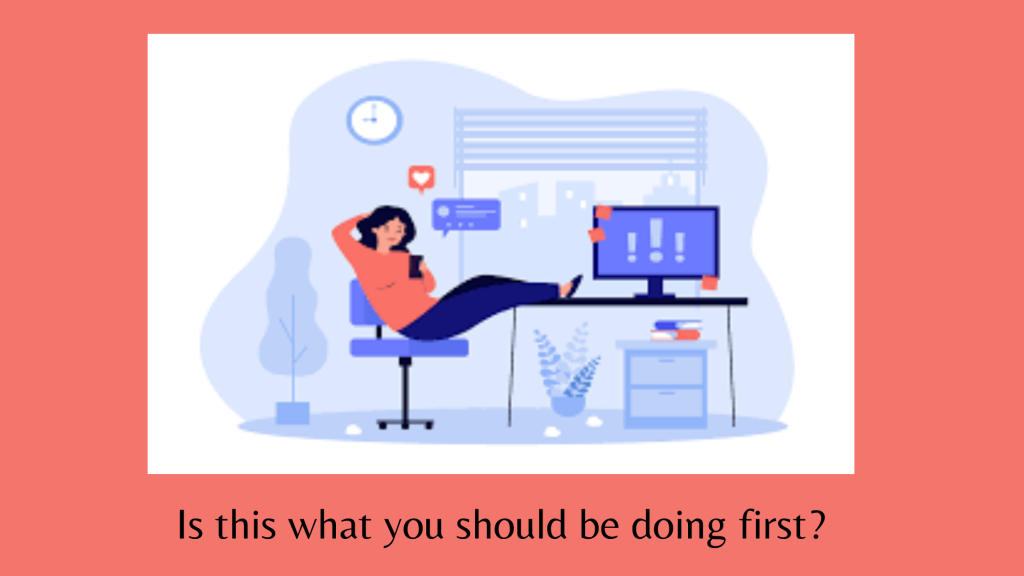
Procrastinating means to put off doing something. The definition doesn’t include the words “something important,” but that’s usually when we think of it. Because often when we’re putting off something – the bills, returning a call, setting up a meeting with our principal – we’re getting lots of other things done. Just not the one that banging around in our heads, the one we can’t stop thinking about that we know needs to get done.
There is no doubt about it. That list of check marks on the unimportant tasks probably means we’re avoiding the priority or the most impactful action. Why do we do that to ourselves? And how can we stop doing it? Greg Vanourek tackles the problem in How to Stop Avoiding Things: 17 Practices:
- Start by noticing your avoidance practices – Awareness is always the first step in being able to deal with a problem. What are you go-to tasks that alert you to the fact that you’re avoid something bigger. (Email? Facebook?)
- Seek the root cause of your avoidance behavior – It may be feeling uncertain about how to handle the specific task. It could be something frightening such as dealing with a book challenge and/or preparing for a board meeting where your book selection practices are being questioned. Knowing what’s behind your choices can help you make a change.
- Process your emotions – Recognize the emotions. Allow yourself to feel and express them. Vanourek suggests journaling or exercising. Both of these can change your physiological state and put you in a better mindset.
- Divide the problem you’re avoiding into smaller, more manageable chunks – It’s the old adage about how to eat an elephant. And as you complete each chunk, you feel successful and ready to tackle the next chunk. Momentum helps you keep going.
- Start with an easy task or small encounter to get momentum – This works like chunking and gives you a way to get into action – sometimes the hardest part.
- Look for ways to boost your motivation for a better result– Keep track of what you are accomplishing. Consider a Success Journal or visible check list. Cheer your own progress.
- Reframe a situation to note the positives and refrain from focusing only on the negatives – This may a very challenging project, which is why you were avoiding it in the first place. Keep your focus on the positive results you’re aiming for. If it’s something you are uncertain about handling, consider this a step in your learning. For a book challenge issue, see yourself joining those who stand up for our core values and beliefs as a librarian.
- Quiet your negative self-talk – Not easy, but reframing will help. Vanourek suggests being compassionate with yourself, “we are all works in progress.” Know that mistakes are a part of the process, not a reason to stop.
- Practice your communication skills – Be ready to talk about the benefits and challenges of what you’re doing by always keeping your communication skills strong. Then you can confidently as you express yourself and when asking for help when needed.
- Set a deadline for taking action – “By when’s” are vital to starting and continuing. “I’ll have this step done before Wednesday/noon/break.” It also gives you goals and milestone to reach.
- Build action habits – The more you see yourself doing – and as being a doer – the easier it will be to continue. Momentum is your friend.
- Recognize that addressing something you’ve been avoiding can make you feel powerful – Instead of carrying around the heaviness of your thoughts as you think about this project and the fact that it’s still not done, taking even that first step will be empowering. You’ll inspire yourself to take the next.
- Work on your problem-solving skills –Vanourek suggests exploring creative ways of dealing with problems even before you get to a project that you want to avoid. Knowing you are good at problem-solving will help you spend less time procrastinating.
- Develop your tolerance and flexibility – Rigid ways of thinking rarely help us out of difficult situations and challenging emotions. Be open to the process and recognize some problems are beyond your ability. Look for ways to get help – such as your PLN.
- Work on improving your coping skills and strategies – Some suggested questions to ask yourself: “How might I address this? What would my best self do in this situation?
- Resist your urge to avoid when it appears – Now that you recognize your avoidance behaviors, you are better equipped to deal with them. Get into action as soon as possible. The longer you wait, the harder it is to get going.
- Get support – You don’t have to do everything on your own. Look to see who handles this better than you and ask for help. Mentors can be useful in this.
This is a long list – and a long post. If any of these points hit you, then make a change. And if you’re reading this instead of tackling that responsibility you’ve been avoiding? It’s time to get to work.


